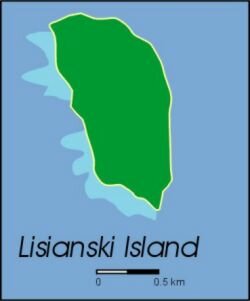About 20 million years ago, geologic forces raised the tip of a huge coral bank above sea level. Today, Lisianski Island is 1.5 square kilometers (381 acres), about the size of Honolulu. Its highest point is a sand dune about 40 feet above sea level. Though the island is small, the reef area to the southeast, called Neva Shoals, is huge, covering 979 square kilometers, an area nearly the size of O`ahu.

A Hawaiian gourd calabash was spotted on the beach of Lisianski in 1805, when the ship Neva ran aground there. Captain Iurii Lisianskii (aka Urey Lisiansky) jettisoned some of the ship's cargo, including cannons, to free the ship from the shallow waters.
A vessel picking up survivors of a shipwreck introduced rats to the island in 1844. Later, rabbits and mice devastated the island's ecology and are believed to have caused the demise of the Laysan rail. Feather collecting began on Lisianski about 1904. In response to public outcry about the feather trade, Theodore Roosevelt established the Hawaiian Island Bird Reservation, which included Lisianski, in 1909. An armed party landed on the island in 1910. They arrested feather poachers and confiscated and destroyed about 1.4 tons of feathers, representing 140,400 birds.
Today, Hawaiian monk seals and green sea turtles are common visitors to Lisianski's sandy white beaches. Migratory shorebirds seen on the island include the kolea (golden plover), ulili (wandering tattler), and kioea (bristle-thighed curlew). Nearly three-fourths of the Bonin petrels nesting in Hawai`i make this island their home. In some years, more than a million sooty terns visit Lisianski.
Reef fishes of the nearshore waters are abundant and diverse. Researchers have found predators near Lisianski's reefs such as sharks to be very aggressive. Even ulua (Trevally jacks) will harass divers and small boats. The reefs are called "coral gardens" by some scientists because of their abundance of coral. Twenty-four different species of coral were found in one major survey at Lisianski.
A wide variety of algae are commonly found close to the island, and some researchers think that this results from guano (bird droppings) washing into the ocean and providing nutrients for the algae.
|

